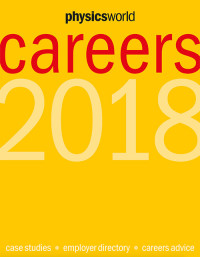Last year, we launched our first ever Physics World Careers guide, which brought together all of our best content from the careers section of our monthly magazine, together with an extensive directory of employers. This year, we’re back with the bigger Physics World Careers guide 2018, packed with case-studies and analyses, to help you choose the right path for your future – as James McKenzie, vice-president for business at Institute of Physics point out in his foreword for the guide, “As physicists, you will have learnt to be logical, analytical and articulate. These are skills that are highly prized by employers and open up many career paths for you.”
Blog
Got your physics degree… now what?
View all posts by this author | View this author's profile
Photography prize, Tesla collision course, climate-change cross stitch
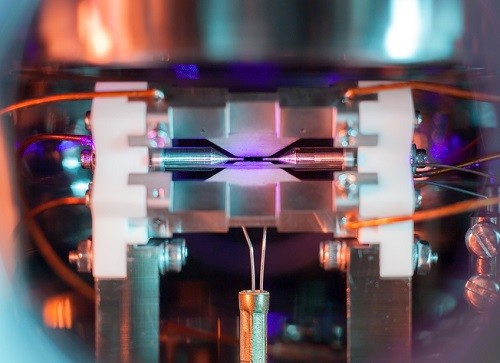
Pale blue dot: image of a strontium atom in an ion trap bags national photography prize (courtesy: David Nadlinger – University of Oxford)
By Michael Banks
An image of a single positively-charged strontium atom that is held in an ion trap by electric fields has won a national science photography competition organised by the UK’s Engineering and Physical Sciences Research Council.
Taken by PhD student David Nadlinger from the University of Oxford, the image shows the light emitted from the atom when it absorbs laser light tuned to a specific frequency. The picture was taken through a window of the ultra-high vacuum chamber that houses the ion trap.
“The idea of being able to see a single atom with the naked eye had struck me as a wonderfully direct and visceral bridge between the minuscule quantum world and our macroscopic reality,” says Nadlinger. “When I set off to the lab with camera and tripods one quiet Sunday afternoon, I was rewarded with this particular picture of a small, pale blue dot.”
Moving onto space, the successful launch of SpaceX‘s Falcon Heavy rocket last week resulted in a Tesla Roadster (formally owned by SpaceX boss Elon Musk) in orbit around the Sun. Used only as a test mass, the car featured a spacesuit-clad mannequin called “Starman” in the driver’s seat.
Physics of ski jackets, the eerie sound of thin ice, how figure skaters linger in mid-air
By Michael Banks and Hamish Johnston
Probably with an eye on the Winter Olympics, which starts today, two firms have just released new ranges of high-tech ski jackets. The Swiss technology business Osmotex and the Swiss Federal Laboratories for Materials Science and Technology premiered their new ski jacket at the sport and sportwear international (ISPO) trade fair in Munich. It contains an “electro-osmotic” membrane called HYDRO_BOT in the fabric so that when membrane is switched on with a conventional battery it speeds up the transfer of salt ions across the membrane, taking them away from your sweaty skin. The creators claim it can pump out 10 litres of liquid per square metre per hour. For more details, see the video above.
View all posts by this author | View this author's profile
12 things we learned about the National Physical Laboratory
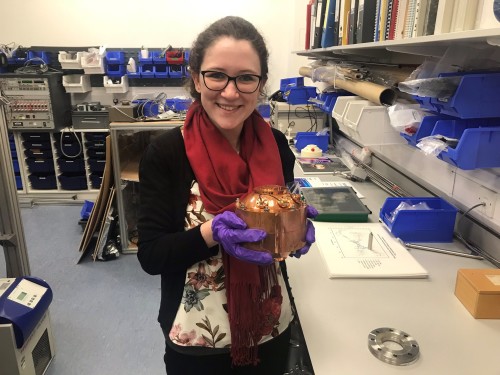
Hands-on physics – Sarah Tesh with a replica of the device used to measure temperature at the National Physical Laboratory
By Matin Durrani and Sarah Tesh
Here at Physics World we’re planning to publish special issues later this year on time (in July) and on SI units and measurement (in November). So to find out more about the latest work in these fields, we decided to accept a long-standing invitation to visit the National Physical Laboratory in Teddington, just outside London, yesterday.
The NPL is the UK’s national measurement laboratory and, as we found out on our visit yesterday, it’s home to almost 900 staff. Or, to be precise, there are 879 staff – after all, accuracy is the name of the game for the NPL, which provides vital measurement services to industry and plays a key part in global attempts to revise the SI measurement system.
It was a busy day for us and we came away with some useful ideas for possible articles for those two Physics World special issues. But rather than giving you a detailed run-down of everything we saw, here instead are 12 “fun” facts we picked up during our visit. Sometimes it’s those little details that make lab visits so intriguing.
View all posts by this author | View this author's profile
Happy Hedgehog Day, play like Einstein, Hawking could be in court over NHS
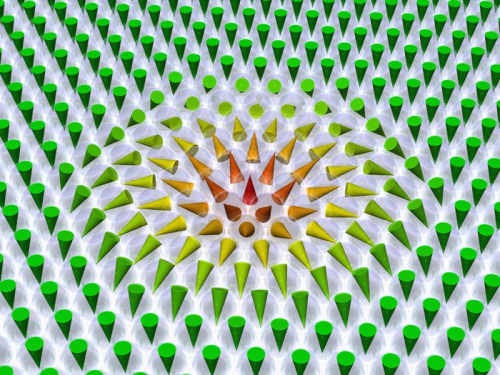
Magnetic hedgehog: illustration of a skyrmion (Courtesy: Wiesendanger Group, University of Hamburg)
By Michael Banks and Hamish Johnston
Today, people are celebrating Hedgehog Day – possibly as an alternative to Groundhog Day, which is a tradition in North America. There is a nice connection between the spiny critters and physics because diagrams illustrating magnetic quasiparticles called skyrmions are sometimes referred to as hedgehogs. This is because the magnetization associated with a skyrmion can resemble the spines of the hedgehog. The above image is from a news story about skyrmion research done by Kirsten von Bergmann, André Kubetzka and Roland Wiesendanger at the University of Hamburg.
View all posts by this author | View this author's profile
The February 2018 issue of Physics World magazine is now out
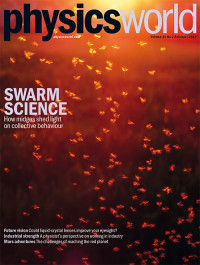 By Matin Durrani
By Matin Durrani
You’ll be delighted to know that the February 2018 issue of Physics World is now out in print and digital format.
In our cover feature this month, science writer Jennifer Ouellette discovers how tiny midges can shed light on collective behaviour in physics. You can also discover from Helen Gleeson how physicists are seeking to create liquid-crystal contact lenses – and learn from Stephen Ornes more about the technological challenges of going to Mars.
Don’t miss either our interview with the physicist who heads Japan’s leading funding agency and find out from astrophysicist Elizabeth Tasker about her experiences as an overseas scientist in the country.
And our veteran North America correspondent Peter Gwynne assesses the impact that Donald Trump has had on US science, one year into his presidency.
Remember that if you’re a member of the Institute of Physics, you can read the whole of Physics World magazine every month via our digital apps for iOS, Android and Web browsers.
Let us know what you think about the issue on Twitter, Facebook or by e-mailing us at pwld@iop.org
View all posts by this author | View this author's profile
A virtual tour of virtual reality
By Margaret Harris at Photonics West in San Francisco
“How many people in this room are wearing smart glasses today?”
When Bernard Kress, a photonics expert and optical architect on Microsoft’s HoloLens smart-glasses project, posed this question at the Photonics West trade show, he had reason to expect a decent response. He was, after all, speaking at a standing-room-only session on virtual reality, augmented reality and mixed reality (VR, AR and MR), and the audience was packed with tech-friendly, early-adopter types who had come specifically because they’re interested in such devices. Surely, someone in the audience would put up their hand.
View all posts by this author | View this author's profile
Watch the super blue blood moon eclipse live
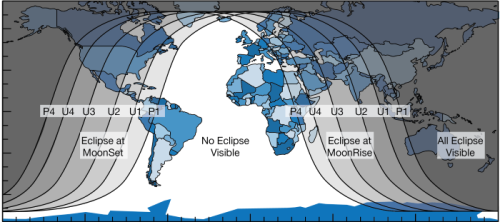
Eclipse watching: where the blood moon will be visible (Courtesy: NASA)
By Hamish Johnston
Tomorrow, people around much of the world should be able to see a lunar triple-whammy. There are two full moons this month, which is a relatively rare occurrence called a blue moon. The Moon is also near its closest approach to Earth, which means that it will loom large in the sky as a super moon.
View all posts by this author | View this author's profile
Physicists bag Australian and Senior Australian of the Year, Doomsday Clock ticks closer to midnight
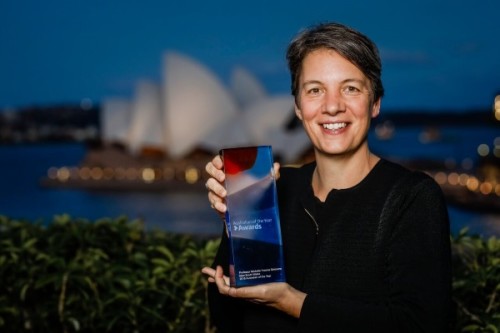
Award winning: Australian of the Year Michelle Simmons (Courtesy: UNSW)
By Hamish Johnston
Today is Australia Day, when the prestigious Australian of the Year award is conferred. This year’s winner is the quantum physicist Michelle Simmons of the University of New South Wales who famously built a transistor from just one atom and also created what could be the world’s thinnest wire. Also honoured today is biophysicist Graham Farquhar of the Australian National University. He is Senior Australian of the Year for 2018 and an expert in photosynthesis. It looks like this will be a bonzer year for physics in Oz.
View all posts by this author | View this author's profile
Lucky physicists, runways renamed as magnetic poles shift, what happened to the Zuma spacecraft?
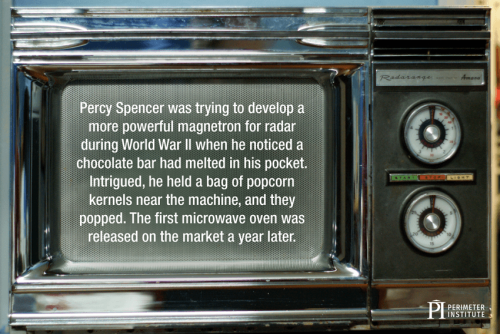
Lucky ping: the invention of the microwave oven. (Courtesy: Perimeter Institute)
By Hamish Johnston
“In the fields of observation, fortune favours the prepared mind,” is a quote attributed to Louis Pasteur and it encapsulates the role of luck in scientific investigation. The Perimeter Institute for Theoretical Physics in Canada has put together a list of eight scientific breakthroughs that benefited from a little luck. Examples include Ernest Rutherford and colleagues measuring alpha-particle backscattering when they were really interested in how the particles travelled through the target – which resulted in the discovery of the atomic nucleus. But my favourite is how the microwave oven was invented, as described above.
View all posts by this author | View this author's profile
